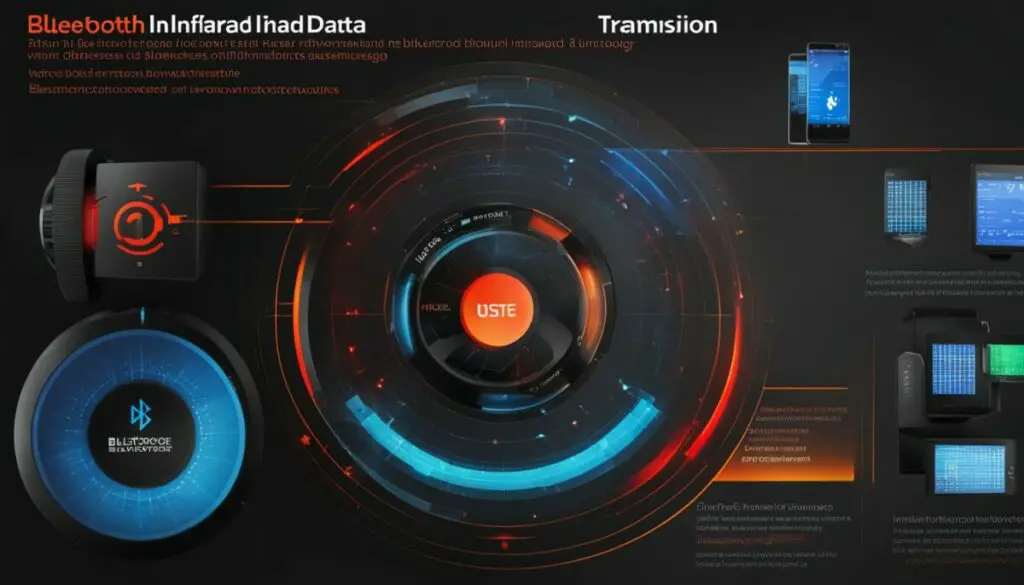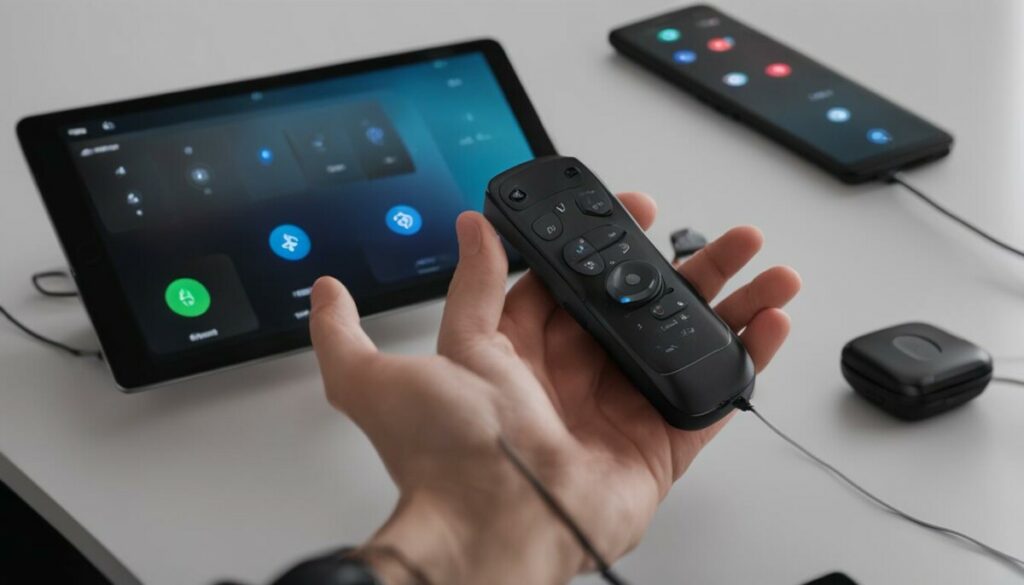Last Updated on 5 months by Francis
Bluetooth remotes and infrared remotes are two popular options for controlling devices. In this article, we will compare these two technologies to determine their advantages and differences.
Contents
Key Takeaways:
- Bluetooth remotes use low-powered radio waves, while infrared remotes use high-powered infrared waves for data transmission.
- Bluetooth remotes generally have a longer range than infrared remotes, making them suitable for controlling devices further away.
- Infrared remotes require a direct line of sight to the device, while Bluetooth remotes can work even with obstacles in the way.
- Bluetooth remotes can connect to multiple devices simultaneously, while infrared remotes operate on a one-to-one basis.
- Bluetooth technology has made advancements in reducing power consumption, making Bluetooth remotes more energy-efficient.
How They Transmit Data: Bluetooth vs. Infrared

Bluetooth and infrared remotes use different methods to transmit data. Infrared remotes utilize high-powered infrared waves to send signals between the remote control and the device being controlled. On the other hand, Bluetooth remotes rely on low-powered radio waves to establish a connection between the remote and the target device.
This difference in transmission technology brings about several advantages of Bluetooth remotes over infrared remotes. Firstly, Bluetooth remotes have a faster transmission speed compared to infrared remotes. This means that commands sent from a Bluetooth remote are executed more quickly, resulting in a more responsive and seamless user experience.
Additionally, Bluetooth remotes consume less energy compared to infrared remotes. The low-power radio waves used by Bluetooth remotes contribute to improved energy efficiency, ensuring that the battery life of the remote is prolonged. This is particularly beneficial for battery-powered devices, as it reduces the frequency of battery replacements.
Overall, the use of Bluetooth technology in remotes offers superior performance and efficiency when compared to infrared technology. The faster transmission speed and lower energy consumption make Bluetooth remotes a compelling choice for users seeking optimal performance and convenience.
| Advantages of Bluetooth Remotes | Advantages of Infrared Remotes |
|---|---|
|
|
Range and Coverage: Bluetooth vs. Infrared

When comparing Bluetooth remotes and infrared remotes, one of the key factors to consider is their range and coverage. Bluetooth remotes typically have a longer reach compared to infrared remotes, making them more effective in controlling devices that are located further away.
Bluetooth remotes have a typical range of 10 meters, which can extend up to an impressive 250 meters in certain cases. This means that you can control your devices from a considerable distance, allowing for greater flexibility and convenience. In contrast, infrared remotes have a range of only 5 meters, limiting their effectiveness for controlling devices that are not within close proximity.
Another advantage of Bluetooth remotes over infrared is their ability to work without a direct line of sight to the device being controlled. Infrared remotes require a clear line of sight, meaning you have to point the remote directly at the device for it to work properly. This can be cumbersome and limiting, especially if there are obstacles in the way. Bluetooth remotes, on the other hand, can work even if there are walls or other objects obstructing the line of sight, providing greater flexibility in terms of device placement.
| Factors | Bluetooth Remotes | Infrared Remotes |
|---|---|---|
| Range | 10 meters (up to 250 meters in some cases) | 5 meters |
| Line of Sight | Not required | Required |
| Device Placement | Flexible | Limited by line of sight |
“The longer range and ability to work without a direct line of sight make Bluetooth remotes a more reliable and convenient option for controlling devices.”
In conclusion, when it comes to range and coverage, Bluetooth remotes have a definite advantage over infrared remotes. With their longer reach and ability to work without a direct line of sight, Bluetooth remotes offer greater flexibility and convenience in controlling devices that are located further away. Whether it’s controlling your TV from across the room or adjusting the volume on your soundbar from another part of the house, Bluetooth remotes are the more effective choice.
Line of Sight and Device Position: Bluetooth vs. Infrared

One key difference between Bluetooth and infrared remotes is how they require line of sight to the controlled device. Infrared remotes rely on direct line of sight, meaning you need to point the remote directly at the device for it to work. This limitation can be inconvenient, especially if you have multiple devices spread across a room or if your devices are placed in cabinets or behind obstacles.
On the other hand, Bluetooth remotes do not require a direct line of sight. Bluetooth technology uses radio waves, which can penetrate obstacles like walls and furniture. This makes Bluetooth remotes more versatile in terms of device placement. You can control devices even if they are not within your line of sight, allowing for more flexibility and convenience in how you interact with your devices.
With Bluetooth remotes, you can control devices even if they are located in another room or hidden behind furniture. This can be particularly useful for home theater setups or smart home systems where devices are often positioned in different areas of a room or house. Bluetooth remotes give you the freedom to control your devices from a comfortable position without worrying about alignment or direct line of sight.
“Bluetooth remotes offer the convenience of controlling devices without the need for a direct line of sight. This is especially beneficial in scenarios where devices are not easily accessible or when you want to control multiple devices from a single remote.” – Tech Expert
| Line of Sight | Bluetooth | Infrared |
|---|---|---|
| Requires direct line of sight | No | Yes |
| Can control devices behind obstacles | Yes | No |
| Allows control from another room | Yes | No |
Number of Connections: Bluetooth vs. Infrared

When it comes to the number of connections, Bluetooth remotes have a clear advantage over infrared remotes. Bluetooth technology allows for multiple connections simultaneously, making it more versatile for controlling multiple devices at once. This is particularly beneficial in scenarios where you need to control various devices in your home entertainment system, such as a TV, soundbar, and streaming device.
In contrast, infrared remotes typically operate on a one-to-one basis, meaning they can only control a single device at a time. This limitation can be inconvenient if you have multiple devices in close proximity that you want to control simultaneously. With Bluetooth remotes, you can easily switch between devices without the need for additional remotes or complicated setup processes. This makes Bluetooth remotes a superior choice for better performance and convenience.
Energy Consumption: Bluetooth vs. Infrared

When comparing Bluetooth remotes to infrared remotes, one important factor to consider is their energy consumption. Both technologies have relatively low energy requirements, but Bluetooth remotes have made advancements in reducing power consumption. This is particularly true with the introduction of Bluetooth Low Energy (BLE) mode.
Bluetooth Low Energy mode allows devices to operate with minimal power usage, making it ideal for battery-powered devices such as remote controls. By optimizing power consumption, Bluetooth remotes can provide extended battery life, reducing the frequency of battery replacements.
In contrast, infrared remotes consume slightly more power due to their high-powered infrared wave transmission. While the difference in energy consumption may be minimal, it can make a difference in the long run, especially for devices that rely on battery power.
Table: Energy Consumption Comparison
“Bluetooth remotes with their low energy consumption offer the advantage of extended battery life, making them a reliable choice for energy-conscious consumers.”
In conclusion, when it comes to energy consumption, Bluetooth remotes have an edge over infrared remotes. Their lower power requirements, especially with the introduction of Bluetooth Low Energy mode, make them a more energy-efficient option. This can result in longer battery life, reducing the hassle and cost of frequent battery replacements.
Practical Applications: Bluetooth vs. Infrared
Bluetooth and infrared remotes have different practical applications based on their technological capabilities. Infrared remotes have long been the go-to choice for controlling common home entertainment devices such as TVs, DVD players, and stereo systems. The simplicity and affordability of infrared technology have made it widely accessible and compatible with a variety of devices. However, Bluetooth technology has expanded beyond traditional home entertainment and is now integrated into smartphones, game consoles, and smart TVs, among other devices. This versatility and compatibility across different devices make Bluetooth remotes a preferred choice for many users.
With the rise of smart home technology, Bluetooth remotes have found new applications in controlling a wide range of connected devices. From smart bulbs and thermostats to voice assistants and home security systems, Bluetooth remotes offer a seamless way to manage various aspects of a modern smart home. This integration allows users to control multiple devices simultaneously, providing convenience and efficiency.
Furthermore, Bluetooth technology enables wireless connectivity and eliminates the need for a direct line of sight between the remote and the device being controlled. This opens up possibilities for controlling devices that are not easily accessible or are located in another room. Bluetooth remotes can communicate through walls and obstacles, making them more versatile in terms of device placement.
Overall, the practical applications of Bluetooth remotes extend beyond traditional home entertainment, making them a preferred choice in the era of smart home technology. While infrared remotes continue to serve their purpose in controlling basic devices, Bluetooth technology offers greater compatibility, versatility, and convenience for a wide range of modern devices and applications.
Compatibility and Cost: Bluetooth vs. Infrared
When it comes to compatibility, Bluetooth remotes have a significant advantage over infrared remotes. Bluetooth is a standard technology that is built into many devices, making it more compatible across different manufacturers. Whether you have a smartphone, tablet, or smart TV, chances are it already has Bluetooth capabilities. Infrared technology, on the other hand, may not be supported by all devices, especially older ones. If you’re looking for a remote that can seamlessly connect to various devices without compatibility issues, Bluetooth remotes are the way to go.
In terms of cost, Bluetooth remotes tend to be more expensive than infrared remotes. This is primarily due to the advanced technology involved in Bluetooth remotes. Bluetooth technology offers features such as longer range, multiple device connections, and compatibility with a wide range of devices, all of which contribute to its higher price point. On the other hand, infrared remotes are simpler in design and operation, making them more affordable for users on a budget. If cost is a determining factor for you, infrared remotes may be a more economical choice.
It’s important to weigh the advantages and disadvantages before making a decision. Bluetooth remotes offer greater compatibility with various devices and manufacturers but come at a higher cost. Infrared remotes, on the other hand, are more affordable but may have limited compatibility with older devices. Consider your specific needs and budget when choosing between Bluetooth and infrared remotes to ensure you make the best decision for your home entertainment setup.
| Factors | Bluetooth Remotes | Infrared Remotes |
|---|---|---|
| Compatibility | High | Variable |
| Cost | Higher | Affordable |
| Range | Longer | Shorter |
| Multiple Device Connections | Yes | No |
As seen in the table above, Bluetooth remotes offer higher compatibility, longer range, and the ability to connect to multiple devices simultaneously. Infrared remotes, on the other hand, are more affordable but have limited compatibility and range. Consider these factors when deciding which type of remote is best suited for your needs. Keep in mind that the specific features and capabilities of each remote may vary depending on the brand and model you choose.
Conclusion
After comparing Bluetooth remotes and infrared remotes, it is clear that Bluetooth remotes offer several advantages over their infrared counterparts. With a longer range and the ability to connect to multiple devices simultaneously, Bluetooth remotes provide more versatility and convenience. Additionally, Bluetooth technology is widely supported by various devices, making it a preferred choice for many users.
However, infrared remotes still have their merits. They are simple to use and more affordable, making them a popular choice for those on a budget or looking for a straightforward solution. Infrared remotes are also commonly used for controlling TVs, DVD players, and other home entertainment devices.
When it comes to determining which is more effective, the answer depends on individual needs and preferences. If range, versatility, and compatibility with multiple devices are important factors, Bluetooth remotes are the way to go. On the other hand, if simplicity and affordability are key considerations, infrared remotes may be the better option.
In conclusion, both Bluetooth and infrared remotes have their strengths and weaknesses. Understanding the differences between the two technologies will help users make informed decisions when choosing the remote control that best suits their specific requirements.
FAQ
Are Bluetooth remotes better than infrared?
Bluetooth remotes offer greater range, versatility, and compatibility with multiple devices, making them a preferred choice for many users. However, infrared remotes are still widely used for their simplicity and affordability. The choice between the two ultimately depends on the specific needs and preferences of the user.
How do Bluetooth remotes and infrared remotes transmit data?
Infrared remotes use high-powered infrared waves, while Bluetooth remotes use low-powered radio waves. This difference in transmission technology can affect factors such as energy consumption and transmission speed.
What is the difference in range and coverage between Bluetooth and infrared remotes?
Bluetooth remotes typically have a longer reach than infrared remotes. Bluetooth has a typical range of 10 meters, extending up to 250 meters in some cases. In contrast, infrared remotes have a range of only 5 meters.
Do Bluetooth remotes require a direct line of sight to the device being controlled?
No, Bluetooth remotes do not require a direct line of sight. They can work even if there are obstacles in the way, such as walls. In contrast, infrared remotes require a direct line of sight to the device being controlled.
Can Bluetooth remotes be connected to multiple devices simultaneously?
Yes, Bluetooth remotes can be connected to multiple devices simultaneously. In contrast, infrared remotes typically operate on a one-to-one basis, limiting them to controlling a single device at a time.
Which type of remote has lower energy consumption?
Both Bluetooth and infrared remotes have relatively low energy consumption. However, Bluetooth technology has made advancements in reducing power consumption, especially with the introduction of Bluetooth Low Energy mode, making Bluetooth remotes more energy-efficient.
What are the practical applications of Bluetooth and infrared remotes?
Infrared remotes have been widely used for controlling TVs, DVD players, and other home entertainment devices. Bluetooth technology, on the other hand, is used in a wide range of devices including smartphones, game consoles, and smart TVs.
Which type of remote is more compatible and cost-effective?
Bluetooth is a standard technology that is built into many devices, making it more compatible across different manufacturers. Infrared technology, on the other hand, may not be supported by all devices, especially older ones. In terms of cost, Bluetooth remotes tend to be more expensive than infrared remotes due to the advanced technology involved.








